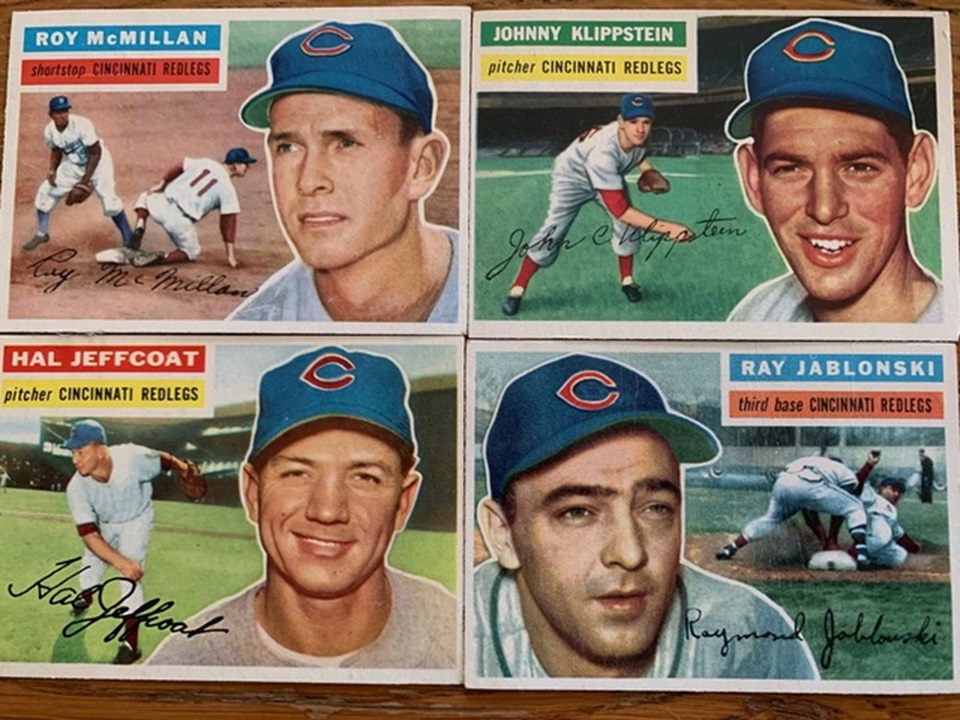
The cards banged against the brick wall of my grade school. It was recess and we were playing cards. Our teachers knew what we were doing. Gambling.
The stakes were high. At least we thought so. Whoever had a card closer to that red brick wall won. Even if a card was right smack against that wall, it was no guarantee of a win. A leaner, when a card “stood up” against that wall, would guarantee a win.
What constituted a win? All the baseball cards that were tossed. Simple.
Actually, not so simple. Heartbreak could be involved. I would bring my stack of cards to school every day. It would include my most treasured cards, the New York Yankees.
A couple of years earlier, my Dad and uncles took me and a passel of cousins from Connecticut by train to a Yankee game. Mickey Mantle hit a home run. I was hooked, both on trains, baseball, and Mickey Mantle.
I wouldn’t see a train car again for a couple of years. Then, in 1955, I saw them floating down the Naugatuck River in one of those, we were told, once-in-a-century storms. Actually, it may have been a shot over the bow. It could have been an early sign of the impact of too much carbon in the atmosphere.
Anyway, my paper route gave me the change to buy a lot of bubble gum with those baseball cards tucked inside.
My Yankee cards were at the bottom of my stack. I wouldn’t play them unless in a desperate situation. If the recess bell rang and I was losing, that was desperation. I lost my Mickey Mantle card that way.
I became an inveterate collector of baseball cards. My older sister, always better organized than me, helped put them in a picture album. Some we taped – I would regret that later – and some we used photo edge holders. Later we moved them to plastic sheets.

After doing this for a few years, I noticed a strange pattern. My Cincinnati Reds cards morphed into the Red Legs. What?
I asked my parents to explain what was going on here. No help. I went to the final authority, my older sister who was smarter than anyone in the family.
She gave a very passable answer. They couldn’t change to Red Sox since the Boston team already had that moniker.
I found that an acceptable explanation as all Yankee fans were well acquainted with the hated Bo Sox. That was it. It never dawned on me to ask why the change from Reds to Red Legs.
It was around this time that I heard a very scary story. I pointed to a tower on a far hill and asked my Mom what that was. She explained that it held water. Then she knelt down beside me and whispered the scary part in my ear. They say the communists were going to poison the water.
I went silent. I’m sure that she saw the frightened look on my face. My Mom assured me that our water was safe for now.
Some fifteen years later I learned the truth. It was the United States military, with a lot of help from Dupont and other chemical companies, that was using Agent Orange to poison the soils, waters, and food of the Vietnamese people. Napalm and white phosphorus, the latter of which is now being used by the Israeli military on Palestinians, were used directly on a peasant people.
My Mom, warm and endearing with an ever-present smile, was apolitical. She had picked up anti-communist propaganda from the far right at that time.
Senator Joe McCarthy, coached by the same Roy Cohen who nurtured big lie Donald Trump, needed such lies circulated to justify the witch-hunting of communists, labor leaders, and peace and social justice activists. It was the same fascistic atmosphere that snared Robert Oppenheimer. His wife, brother, and friends were communists. He also came out against the hydrogen bomb.
Time, truth, and diligent work by the left progressives caught up with the fascist bully on December 2nd, 1954. The U.S. Senate voted to censure Senator McCarthy by a vote of 67–22. It made him one of the few senators ever to be disciplined in this fashion.
The Cincinnati Reds name was restored by 1959 and “Reds” returned to the uniform inside the wishbone-C.
In 1971, a neighborhood friend and I grabbed our backpacks and hitchhiked north through Maine. It seemed most youth were on the move seeking answers to the U.S. War in Vietnam, racism, and the social movements to stem the tide of both. We stopped in a small town where, we were told, friends would help us on our journey.
When we showed up, our new friends just got back from playing baseball. The name of their team was blazoned on their uniforms – Reds.
We hope you appreciated this article. At People’s World, we believe news and information should be free and accessible to all, but we need your help. Our journalism is free of corporate influence and paywalls because we are totally reader-supported. Only you, our readers and supporters, make this possible. If you enjoy reading People’s World and the stories we bring you, please support our work by donating or becoming a monthly sustainer today. Thank you!










